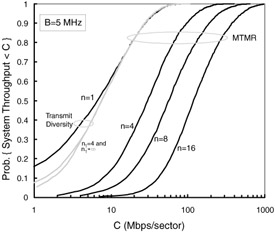14.5 System Throughput
14.5 System Throughput
In this section, we extend our analysis in order to reevaluate the throughput achievable in much more realistic conditions. To that extent, we incorporate an entire cellular system into the study.
Most emerging data-centric systems feature time-multiplexed downlink channels, certainly those evolving from TDMA, but also those evolving from CDMA. [39], [40] Hence, same-cell users are mutually orthogonal, and thus the interference arises exclusively from other cells. Accordingly, we consider a time-multiplexed multicell system layout with base stations placed on a hexagonal grid. Users are uniformly distributed and connected to the sector from which they receive the strongest signal. To further mimic actual 3G data systems, rate adaptation with no power control is assumed. Altogether, the results presented in this section can be considered as upper bounds for a 5-MHz data-oriented 3G system.
The results correspond to Monte-Carlo simulations conducted on a 19-cell universe: a central cell, wherein statistics are collected, surrounded by two rings of interfering cells. The cell size is scaled to ensure that the system is basically interference-limited, and thus thermal noise can be neglected. The simulation parameters are summarized for convenience in Table 14.1.
| Multiplexing | Time division |
| Sectors per cell | 3 |
| Base station antennas | 120 perfect sectorization |
| Terminal antennas | Omnidirectional |
| Frequency reuse | Universal |
| Propagation exponent | 3.5 |
| Log-normal shadowing | 8 dB standard deviation |
| Small-scale fading | Rayleigh Independent per antenna |
| Transmit power | Fixed |
| Thermal noise | Negligible |
Figure 14.4 displays cumulative distributions of system throughput (in Mbps per sector) over all locations with multiple transmit antennas only, as well as with multiple transmit and receive antennas. These curves can be interpreted also as peak single-user throughputs, i.e., single-user throughputs (in Mbps) when the entire capacity of every sector is allocated to an individual user. With only multiple transmit antennas, the benefit appears only significant in the lower tail of the distribution, corresponding to users in the most detrimental locations. The improvements in average and peak system capacities are negligible. Moreover, the gains saturate rapidly as additional transmit antennas are added. The combined use of multiple transmit and receive antennas, on the other hand, dramatically shifts the curves offering multiple-fold improvements in throughput at all levels. Notice that, without multiple terminal antennas, the peak single-user throughput that can be supported in 90 percent of the system locations is only on the order of 500 kbps with no transmit diversity and just over 1 Mbps with diversity. Moreover, these figures correspond to absolute upper bounds. With modulation excess bandwidth, training overhead, imperfect channel estimation, realistic coding schemes, and other impairments, only a fraction of these bounds can be actually realized. Without an antenna array mounted on the terminal, user rates on the order of several Mbps can only be supported within a restricted portion of the coverage area and when no other users compete for bandwidth within the same sector.

Figure 14.4: Cumulative distributions of system throughput (Mbps per sector) with multiple transmit antennas only, as well as with multiple transmit and receive antennas. n is the number of antennas. System bandwidth B = 5 MHz.
[39]Bender, P. et al., CDMA/HDR: a bandwidth-efficient high-speed wireless data service for nomadic users, IEEE Commun., 38 (7), 70–77, 2000.
[40]3G TR 25.950, UTRA High Speed Downlink Packet Access, Third Generation Partnership Project, Technical Specification Group Radio Access Network, March 2001.
EAN: 2147483647
Pages: 239